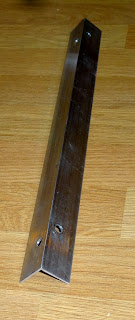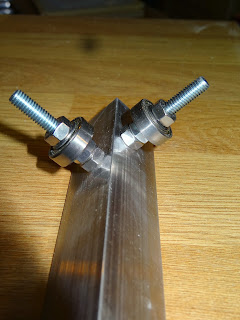Note the rails are offset to the left, this is to leave space for the mounting of the Stepper motor for the Y Axis.
The two aluminium angle pieces are used to hold 4 bearings each. They will be screwed to the underside of the X Axis table and will run along the rails.
Each aluminium angle piece is 13 inches long and needs 4 holes drilling to fit bolts to hold the bearings. Note the holes are offset so the bolt heads don't overlap.
The details are shown in the two photos. The bolts used are 6mm. I have used 2 nuts against the aluminium angle then the bearing and a third nut. I also used washers on either side of the bearings but these may not be necessary. The bolts need to be shortened but I have left them like this for the time being as they do not affect the operation.
Note I pinched this method using the bearings and aluminium angle from the Instructables web site. The method was posted on some excellent videos by Jason Welsh - "Build a CNC Machine" (cannedmushrooms).This is a link to the article
The above photos show how the bearings fit over the rails. The great thing about this method is there is no play from side to side.
The rails now screw to the bottom of the table (the table is 14 inches x 14 inches) using 2 screws for each.










